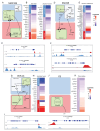This is a preprint.
Investigating the cis-Regulatory Basis of C3 and C4 Photosynthesis in Grasses at Single-Cell Resolution
- PMID: 38405933
- PMCID: PMC10888913
- DOI: 10.1101/2024.01.05.574340
Investigating the cis-Regulatory Basis of C3 and C4 Photosynthesis in Grasses at Single-Cell Resolution
Update in
-
Investigating the cis-regulatory basis of C3 and C4 photosynthesis in grasses at single-cell resolution.Proc Natl Acad Sci U S A. 2024 Oct;121(40):e2402781121. doi: 10.1073/pnas.2402781121. Epub 2024 Sep 23. Proc Natl Acad Sci U S A. 2024. PMID: 39312655 Free PMC article.
Abstract
While considerable knowledge exists about the enzymes pivotal for C4 photosynthesis, much less is known about the cis-regulation important for specifying their expression in distinct cell types. Here, we use single-cell-indexed ATAC-seq to identify cell-type-specific accessible chromatin regions (ACRs) associated with C4 enzymes for five different grass species. This study spans four C4 species, covering three distinct photosynthetic subtypes: Zea mays and Sorghum bicolor (NADP-ME), Panicum miliaceum (NAD-ME), Urochloa fusca (PEPCK), along with the C3 outgroup Oryza sativa. We studied the cis-regulatory landscape of enzymes essential across all C4 species and those unique to C4 subtypes, measuring cell-type-specific biases for C4 enzymes using chromatin accessibility data. Integrating these data with phylogenetics revealed diverse co-option of gene family members between species, showcasing the various paths of C4 evolution. Besides promoter proximal ACRs, we found that, on average, C4 genes have two to three distal cell-type-specific ACRs, highlighting the complexity and divergent nature of C4 evolution. Examining the evolutionary history of these cell-type-specific ACRs revealed a spectrum of conserved and novel ACRs, even among closely related species, indicating ongoing evolution of cis-regulation at these C4 loci. This study illuminates the dynamic and complex nature of CRE evolution in C4 photosynthesis, particularly highlighting the intricate cis-regulatory evolution of key loci. Our findings offer a valuable resource for future investigations, potentially aiding in the optimization of C3 crop performance under changing climatic conditions.
Figures







Similar articles
-
Investigating the cis-regulatory basis of C3 and C4 photosynthesis in grasses at single-cell resolution.Proc Natl Acad Sci U S A. 2024 Oct;121(40):e2402781121. doi: 10.1073/pnas.2402781121. Epub 2024 Sep 23. Proc Natl Acad Sci U S A. 2024. PMID: 39312655 Free PMC article.
-
Evolution of plant cell-type-specific cis-regulatory elements.bioRxiv [Preprint]. 2024 Oct 5:2024.01.08.574753. doi: 10.1101/2024.01.08.574753. bioRxiv. 2024. PMID: 38260561 Free PMC article. Preprint.
-
Photosynthesis of C3, C3-C4, and C4 grasses at glacial CO2.J Exp Bot. 2014 Jul;65(13):3669-81. doi: 10.1093/jxb/eru155. Epub 2014 Apr 10. J Exp Bot. 2014. PMID: 24723409 Free PMC article.
-
The Differences between NAD-ME and NADP-ME Subtypes of C4 Photosynthesis: More than Decarboxylating Enzymes.Front Plant Sci. 2016 Oct 13;7:1525. doi: 10.3389/fpls.2016.01525. eCollection 2016. Front Plant Sci. 2016. PMID: 27790235 Free PMC article. Review.
-
Getting the most out of natural variation in C4 photosynthesis.Photosynth Res. 2014 Feb;119(1-2):157-67. doi: 10.1007/s11120-013-9872-8. Epub 2013 Jun 21. Photosynth Res. 2014. PMID: 23794170 Review.
References
-
- Bowes G, Ogren WL, Hageman RH. Phosphoglycolate production catalyzed by ribulose diphosphate carboxylase. Biochem Biophys Res Commun. 1971. Nov 5;45(3):716–22. - PubMed
-
- Wheeler T, von Braun J. Climate Change Impacts on Global Food Security. Science. 2013. Aug 2;341(6145):508–13. - PubMed
-
- Hatch MD. C4 photosynthesis: a unique elend of modified biochemistry, anatomy and ultrastructure. Biochim Biophys Acta BBA - Rev Bioenerg. 1987. Jan 1;895(2):81–106.
-
- Akhani H, Barroca J, Koteeva N, Voznesenskaya E, Franceschi V, Edwards G, et al. Bienertia sinuspersici (Chenopodiaceae): A New Species from Southwest Asia and Discovery of a Third Terrestrial C4 Plant Without Kranz Anatomy. Syst Bot. 2005. Apr 1;30(2):290–301.
Publication types
Grants and funding
LinkOut - more resources
Full Text Sources
Miscellaneous
